What We’re Reading: August 25th
Review: Auxin signaling
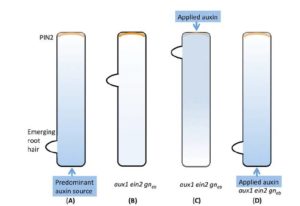 Leyser summarizes our current understanding of the what, how and why of what auxin does (and doesn’t) do. For example, she points out that, “Auxin does not instruct cells to do anything in particular, but rather it influences the behavior of cells according to their pre-existing identity.” She also observes that cells don’t go from a state of no auxin to auxin, as there is always auxin; rather, cells respond to changes in the amount of auxin. The author discusses the specificity of the well-described transcriptional responses to auxin and also how certain auxin responses appear to occur at least somewhat independently of transcriptional changes. Finally, she discusses the role of auxin transporters in auxin-mediated polarization phenomena, and considers models for the role of auxin in root hair placement and evidence in support of (or not) other auxin receptors including ABP1. Plant Physiol. 10.1104/pp.17.00765
Leyser summarizes our current understanding of the what, how and why of what auxin does (and doesn’t) do. For example, she points out that, “Auxin does not instruct cells to do anything in particular, but rather it influences the behavior of cells according to their pre-existing identity.” She also observes that cells don’t go from a state of no auxin to auxin, as there is always auxin; rather, cells respond to changes in the amount of auxin. The author discusses the specificity of the well-described transcriptional responses to auxin and also how certain auxin responses appear to occur at least somewhat independently of transcriptional changes. Finally, she discusses the role of auxin transporters in auxin-mediated polarization phenomena, and considers models for the role of auxin in root hair placement and evidence in support of (or not) other auxin receptors including ABP1. Plant Physiol. 10.1104/pp.17.00765
Special meeting issue, “Enhancing photosynthesis in crop plants: targets for improvement” ($)
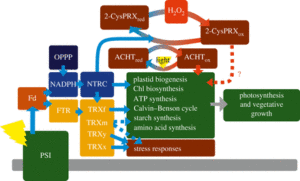 Here’s a great collection of articles that consider various approaches to increase crop productivity through enhancements to photosynthesis. The authors of the papers in this collection include many of the leading photosynthesis researchers, and the topics include structural and architectural improvements at the subcellular level, hacking the thylakoid proton-motive force, photoprotection, models to identify targets for improvement and results from various biochemical interventions. Phil. Trans. Roy. Soc. B. http://rstb.royalsocietypublishing.org/content/372/1730
Here’s a great collection of articles that consider various approaches to increase crop productivity through enhancements to photosynthesis. The authors of the papers in this collection include many of the leading photosynthesis researchers, and the topics include structural and architectural improvements at the subcellular level, hacking the thylakoid proton-motive force, photoprotection, models to identify targets for improvement and results from various biochemical interventions. Phil. Trans. Roy. Soc. B. http://rstb.royalsocietypublishing.org/content/372/1730
Review: Plant phenomics, from sensors to knowledge
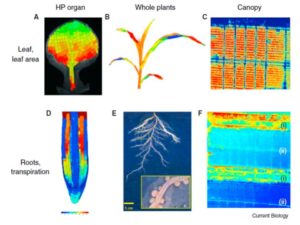 Tardieu et al. have written a comprehensive and very readable overview of the current state and future challenges of plant phenomics, which they define as “the development and application of the suite of tools and methods used for three major goals — (1) capturing information on structure, function and performance of large numbers of plants, together with their environment; (2) analysing, organizing and storing the resulting datasets; and (3) developing models able to disentangle and simulate plant behaviour in a range of scenarios.” They point out that plants’ inherent environmental plasticity makes plant phenomics much more challenging than similar studies in animals, and also that studies that minimize the impacts of environment (e.g., controlled growth conditions) are least relevant for yield predictions. They conclude, “phenomics has reached a stage at which the limiting step is the design of methods and approaches allowing one to take into account different temporal and spatial scales and perform meta-analyses for addressing the challenges of plant adaptation to changing environments and underpin secure food security efforts.” Curr. Biol. 10.1016/j.cub.2017.05.055
Tardieu et al. have written a comprehensive and very readable overview of the current state and future challenges of plant phenomics, which they define as “the development and application of the suite of tools and methods used for three major goals — (1) capturing information on structure, function and performance of large numbers of plants, together with their environment; (2) analysing, organizing and storing the resulting datasets; and (3) developing models able to disentangle and simulate plant behaviour in a range of scenarios.” They point out that plants’ inherent environmental plasticity makes plant phenomics much more challenging than similar studies in animals, and also that studies that minimize the impacts of environment (e.g., controlled growth conditions) are least relevant for yield predictions. They conclude, “phenomics has reached a stage at which the limiting step is the design of methods and approaches allowing one to take into account different temporal and spatial scales and perform meta-analyses for addressing the challenges of plant adaptation to changing environments and underpin secure food security efforts.” Curr. Biol. 10.1016/j.cub.2017.05.055
Reviews: Conventional and unconventional protein secretion ($)
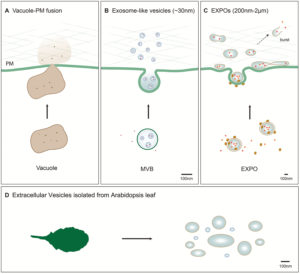 Two reviews in the Journal of Experimental Botany provide updates about protein secretion from plant cells. Wang et al. (10.1093/jxb/erx262) describe the conventional and unconventional pathways of protein secretion. The conventional pathway for protein secretion starts with insertion of the nascent protein into the endoplasmic reticulum, followed by passage trough the Golgi en route to the cell surface in vesicles. More recently, the “unconventional” protein secretion pathway has been described, first in yeast and animal cells and more recently in plants. Proteins secreted via the unconventional pathway lack leader sequences and may or may not be delivered to the cell surface in vesicles. The authors describe different types of unconventional secretion and techniques for the study of this process. In a separate review article, Rodriguez-Furlan et al. (10.1093/jxb/erx261) describe how chemical tools and can be used to study unconventional protein secretion.
Two reviews in the Journal of Experimental Botany provide updates about protein secretion from plant cells. Wang et al. (10.1093/jxb/erx262) describe the conventional and unconventional pathways of protein secretion. The conventional pathway for protein secretion starts with insertion of the nascent protein into the endoplasmic reticulum, followed by passage trough the Golgi en route to the cell surface in vesicles. More recently, the “unconventional” protein secretion pathway has been described, first in yeast and animal cells and more recently in plants. Proteins secreted via the unconventional pathway lack leader sequences and may or may not be delivered to the cell surface in vesicles. The authors describe different types of unconventional secretion and techniques for the study of this process. In a separate review article, Rodriguez-Furlan et al. (10.1093/jxb/erx261) describe how chemical tools and can be used to study unconventional protein secretion.
Medicine is not health care, food is health care: Plant metabolic engineering, diet and human health
 A diet consisting of a wide range of plant matter is optimal for human heath, but due to various historical and social factors (including the relatively high cost of fresh fruit and vegetables), many people don’t get the nutrients they need. Biofortification of staple foods like rice through breeding or genetic engineering provides one strategy to remedy this deficit. Martin and Li review the health benefits of various vitamins and phytonutrients (e.g., polyunsaturated fatty acids and polyphenols), their biosynthetic pathway in plants, and efforts to enhance their content in foods. New Phytol. 10.1111/nph.14730
A diet consisting of a wide range of plant matter is optimal for human heath, but due to various historical and social factors (including the relatively high cost of fresh fruit and vegetables), many people don’t get the nutrients they need. Biofortification of staple foods like rice through breeding or genetic engineering provides one strategy to remedy this deficit. Martin and Li review the health benefits of various vitamins and phytonutrients (e.g., polyunsaturated fatty acids and polyphenols), their biosynthetic pathway in plants, and efforts to enhance their content in foods. New Phytol. 10.1111/nph.14730
Mechanism of enzyme repair by the AAA+ chaperone Rubisco activase ($)
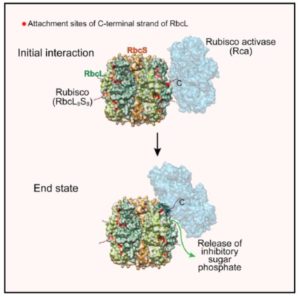 Rubisco is a fascinating enzyme, which in plants is a hexadecamer made up of eight large (RbcL) and eight small (RbcS) subunits. The catalytic sites are buried within the enzyme at the interfaces between pairs of RbcL subunits. Rubisco catalyzes the first step in the carbon-fixing photosynthetic reactions, but it does so inefficiently and with a tendency to make mistakes. One of its accidental products, xylulose-1,5-bisphosphate (XuBP), binds tightly to the active site until it is removed by another enzyme, Rubisco activase (Rca). Bhat et al. investigated the mechanism by which Rca repairs Rubisco. Through hydrogen/deuterium exchange, chemical crosslinking, and Cryo-EM, they found that Rca is able to remove the inhibitors with remarkably little disturbance to the overall structure of the enzyme. (I can’t help but think of my mother carefully unpicking and correcting a mistake in her knitting while reading this paper). Mol. Cell. 0.1016/j.molcel.2017.07.004
Rubisco is a fascinating enzyme, which in plants is a hexadecamer made up of eight large (RbcL) and eight small (RbcS) subunits. The catalytic sites are buried within the enzyme at the interfaces between pairs of RbcL subunits. Rubisco catalyzes the first step in the carbon-fixing photosynthetic reactions, but it does so inefficiently and with a tendency to make mistakes. One of its accidental products, xylulose-1,5-bisphosphate (XuBP), binds tightly to the active site until it is removed by another enzyme, Rubisco activase (Rca). Bhat et al. investigated the mechanism by which Rca repairs Rubisco. Through hydrogen/deuterium exchange, chemical crosslinking, and Cryo-EM, they found that Rca is able to remove the inhibitors with remarkably little disturbance to the overall structure of the enzyme. (I can’t help but think of my mother carefully unpicking and correcting a mistake in her knitting while reading this paper). Mol. Cell. 0.1016/j.molcel.2017.07.004
Temporal and spatial transcriptomic and miRNA dynamics of CAM photosynthesis in pineapple ($)
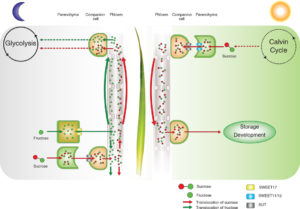 CAM (crassulacean acid metabolism) is the form of photosynthesis in which carbon assimilation occurs at night. CAM allows plants, especially those growing in arid regions, to avoid excessive water loss. With the long-term goal of eventually engineering this water-conserving trait into crop plants, Wai and VanBuren et al. have mapped the patterns of gene expression both temporally and spatially in photosynthetic (green) and non-photosynthetic (white) pineapple leaves. They found that many CAM pathway genes are enriched in clock-associated cis-regulatory regions, which suggests that CAM evolved through neofunctionalization of pre-existing genes. The authors also identified genes likely to be involved in the diurnal cycling of photosynthate from green to white leaf tissues. Plant J. 10.1111/tpj.13630
CAM (crassulacean acid metabolism) is the form of photosynthesis in which carbon assimilation occurs at night. CAM allows plants, especially those growing in arid regions, to avoid excessive water loss. With the long-term goal of eventually engineering this water-conserving trait into crop plants, Wai and VanBuren et al. have mapped the patterns of gene expression both temporally and spatially in photosynthetic (green) and non-photosynthetic (white) pineapple leaves. They found that many CAM pathway genes are enriched in clock-associated cis-regulatory regions, which suggests that CAM evolved through neofunctionalization of pre-existing genes. The authors also identified genes likely to be involved in the diurnal cycling of photosynthate from green to white leaf tissues. Plant J. 10.1111/tpj.13630
Identification of novel growth regulators in plant populations expressing random peptides
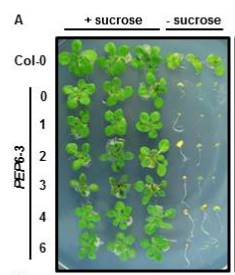 Knowing that many small molecules act as growth regulators, chemical genomics endeavors to identify novel growth-regulating compounds through screening thousands of randomly generated molecules. Knowing that many peptides also act as growth regulators, Bao et al. used a similar approach to look for novel growth regulating peptides. The expressed small peptides of random sequence (potentially cyclizable thorough terminal Cys residues) in transgenic plants and looked for growth alterations. Peptides affecting sucrose-independent growth, red light responses and time of flowering, as well as other effects, were identified, demonstrating the feasibility of this approach for identifying novel bioactive peptides. Plant Physiol.
Knowing that many small molecules act as growth regulators, chemical genomics endeavors to identify novel growth-regulating compounds through screening thousands of randomly generated molecules. Knowing that many peptides also act as growth regulators, Bao et al. used a similar approach to look for novel growth regulating peptides. The expressed small peptides of random sequence (potentially cyclizable thorough terminal Cys residues) in transgenic plants and looked for growth alterations. Peptides affecting sucrose-independent growth, red light responses and time of flowering, as well as other effects, were identified, demonstrating the feasibility of this approach for identifying novel bioactive peptides. Plant Physiol.
Cis and trans determinants of epigenetic silencing by Polycomb repressive complex 2 ($)
 Polycomb repressive complex 2 (PRC2) stably regulates gene expression by initiating repressive histone methylation (specifically, trimethylation of histone H3 at Lys27, H3K27me3). Xiao et al. investigated how PRC2 targets the genes it silences. They identified several Polycomb response elements (PREs) that are binding sites for transcription factors which interact with PRC2. When selected PREs were mutated in reporter constructs, silencing was disabled, and when PREs were introduced silencing was observed, demonstrating their role in gene silencing. The identification of these PREs offers new opportunities for modulating gene expression. Nature Genet. 10.1038/ng.3937
Polycomb repressive complex 2 (PRC2) stably regulates gene expression by initiating repressive histone methylation (specifically, trimethylation of histone H3 at Lys27, H3K27me3). Xiao et al. investigated how PRC2 targets the genes it silences. They identified several Polycomb response elements (PREs) that are binding sites for transcription factors which interact with PRC2. When selected PREs were mutated in reporter constructs, silencing was disabled, and when PREs were introduced silencing was observed, demonstrating their role in gene silencing. The identification of these PREs offers new opportunities for modulating gene expression. Nature Genet. 10.1038/ng.3937
Distinct phases of Polycomb silencing to hold epigenetic memory of cold in Arabidopsis ($)
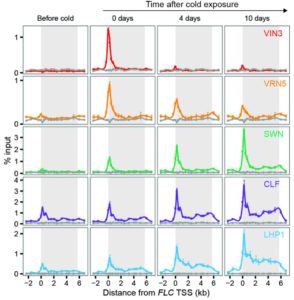 Some plants can only flower after a cold period. This cold period has been shown to cause epigenetic gene silencing of an inhibitor of flowering, which in Arabidopsis is encoded by FLC. Yang and Berry et al. explore the mechanism by which FLC is epigenetically silenced in response to cold. Previous studies showed that the Polycomb Repressive Complex 2 (PRC2), including the subunit CURLY LEAF (CLF), is required for FLC silencing. The authors explored the extent of histone methylation and FLC silencing in various mutant backgrounds. Mutation of clf allowed initial but impersistent silencing. These results suggest a two-step silencing process, starting with nucleation of the histone marks followed by spreading of these silencing marks across the locus, and they propose a model in which spreading is required for long-term silencing that persists through cell divisions. Science 10.1126/science.aan1121
Some plants can only flower after a cold period. This cold period has been shown to cause epigenetic gene silencing of an inhibitor of flowering, which in Arabidopsis is encoded by FLC. Yang and Berry et al. explore the mechanism by which FLC is epigenetically silenced in response to cold. Previous studies showed that the Polycomb Repressive Complex 2 (PRC2), including the subunit CURLY LEAF (CLF), is required for FLC silencing. The authors explored the extent of histone methylation and FLC silencing in various mutant backgrounds. Mutation of clf allowed initial but impersistent silencing. These results suggest a two-step silencing process, starting with nucleation of the histone marks followed by spreading of these silencing marks across the locus, and they propose a model in which spreading is required for long-term silencing that persists through cell divisions. Science 10.1126/science.aan1121
Zygotic genome activation occurs shortly after fertilization in maize
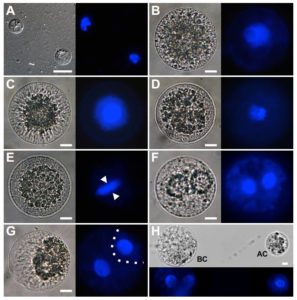 A plant’s life begins with the fusion of haploid egg and sperm cells to produce a diploid zygote. Many of the processes that control early development are under the control of the maternal genome, but at some point there is a shift towards zygotic control. Chen et al. investigated when this shift occurs through transcriptomic analysis of RNA isolated from sperm cells, egg cells, and zygotes at different times after fertilization. They conclude that zygote genome activation occurs shortly after fertilization in maize, and also provide valuable RNA-Seq datasets for use by the community. Plant Cell 10.1105/tpc.17.00099
A plant’s life begins with the fusion of haploid egg and sperm cells to produce a diploid zygote. Many of the processes that control early development are under the control of the maternal genome, but at some point there is a shift towards zygotic control. Chen et al. investigated when this shift occurs through transcriptomic analysis of RNA isolated from sperm cells, egg cells, and zygotes at different times after fertilization. They conclude that zygote genome activation occurs shortly after fertilization in maize, and also provide valuable RNA-Seq datasets for use by the community. Plant Cell 10.1105/tpc.17.00099
Emergence of subgenome dominance across time and ploidy
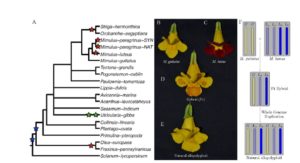 Many plants are not simple diploids (two copies of each chromosome) but are instead are the result of various forms of polyploidization (for example, whole-genome duplication or interspecific hybridization). Polyploidization can disrupt well-established controls over gene expression levels, transposon silencing and other epigenetic processes. Previous studies have indicated that one of the two geneomes (known as subgenomes) tends to become dominant in the polypoloid. Edger et al. address the question of what happens when two different genomes meet, and how quickly, by studying a recent polyploid (approximately 140 years old) and also recreating this polyploid de novo. They conclude that, “subgenome expression dominance occurs instantly following the hybridization of divergent genomes and significantly increases over generations” and also that, “subgenome dominance may be the result of lineage-specific genomic evolution shaping TE densities and methylation levels.” Plant Cell 10.1105/tpc.17.00010
Many plants are not simple diploids (two copies of each chromosome) but are instead are the result of various forms of polyploidization (for example, whole-genome duplication or interspecific hybridization). Polyploidization can disrupt well-established controls over gene expression levels, transposon silencing and other epigenetic processes. Previous studies have indicated that one of the two geneomes (known as subgenomes) tends to become dominant in the polypoloid. Edger et al. address the question of what happens when two different genomes meet, and how quickly, by studying a recent polyploid (approximately 140 years old) and also recreating this polyploid de novo. They conclude that, “subgenome expression dominance occurs instantly following the hybridization of divergent genomes and significantly increases over generations” and also that, “subgenome dominance may be the result of lineage-specific genomic evolution shaping TE densities and methylation levels.” Plant Cell 10.1105/tpc.17.00010
Tomato fruit weight controlled by Cell Size Regulator
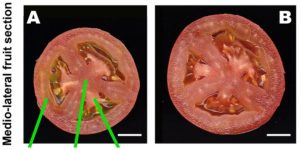 Mu et al. mapped a QTL previously shown to control fruit weight in tomato, and named the responsible gene Cell Size Regulator (CSR). They found that CSR-D, the derived allele, increases cell size and is widespread in Solanum lycopersicum var. lycopersicum, but not in ancestral tomatoes with smaller fruit. The encoded protein is uncharacterized but contains a FAF domain, which has been identified previously in proteins that affect shoot meristem size. PLOS Genet. 10.1371/journal.pgen.1006930
Mu et al. mapped a QTL previously shown to control fruit weight in tomato, and named the responsible gene Cell Size Regulator (CSR). They found that CSR-D, the derived allele, increases cell size and is widespread in Solanum lycopersicum var. lycopersicum, but not in ancestral tomatoes with smaller fruit. The encoded protein is uncharacterized but contains a FAF domain, which has been identified previously in proteins that affect shoot meristem size. PLOS Genet. 10.1371/journal.pgen.1006930
Genome re-sequencing reveals the history of apple and supports a two-stage model for fruit enlargement
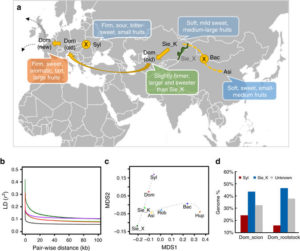 Cultivated apples (Malus domestica) trace their roots to Kazakhstan 4000 – 10,000 years ago, and since then have been propagated, transported, hybridized to other Malus species, and domesticated. Duan et al. sequenced more than 100 diverse accessions to trace apple’s history and identify loci subjected to selection. “During the domestication process, cultivated apples retained the large fruit size from M. sieversii, gained the firm texture and appetizing flavor from the hybridization with M. sylvestris and continued to be bred into larger and firmer fruit with better flavor and aroma.” Genes involved in size, sweetness and acidity, flavor and texture were identified which will be useful for ongoing breeding projects. Nature Comms. 10.1038/s41467-017-00336-7
Cultivated apples (Malus domestica) trace their roots to Kazakhstan 4000 – 10,000 years ago, and since then have been propagated, transported, hybridized to other Malus species, and domesticated. Duan et al. sequenced more than 100 diverse accessions to trace apple’s history and identify loci subjected to selection. “During the domestication process, cultivated apples retained the large fruit size from M. sieversii, gained the firm texture and appetizing flavor from the hybridization with M. sylvestris and continued to be bred into larger and firmer fruit with better flavor and aroma.” Genes involved in size, sweetness and acidity, flavor and texture were identified which will be useful for ongoing breeding projects. Nature Comms. 10.1038/s41467-017-00336-7
Temperature increase reduces global yields of major crops in four independent estimates ($)
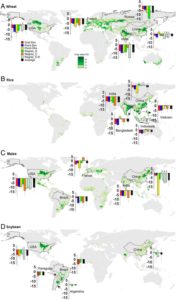 Although future negative impacts on crop yields expected from rising temperature are well known to plant scientists, there are still some members of the broader public that need to be made aware of this problem. Zhao et al. combined four different methods of assessing the impact of increasing temperatures on yields of wheat, rice, maize, and soybean across global and regional areas. Their results will be useful to “develop targeted adaptive strategies to feed a burgeoning world population.” Proc. Natl. Acad. Sci. USA 10.1073/pnas.1701762114
Although future negative impacts on crop yields expected from rising temperature are well known to plant scientists, there are still some members of the broader public that need to be made aware of this problem. Zhao et al. combined four different methods of assessing the impact of increasing temperatures on yields of wheat, rice, maize, and soybean across global and regional areas. Their results will be useful to “develop targeted adaptive strategies to feed a burgeoning world population.” Proc. Natl. Acad. Sci. USA 10.1073/pnas.1701762114
Publishing with objective charisma: Breaking science’s paradox ($)
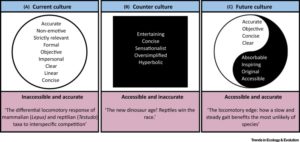 Doublday and Connell ask whether scientific writing has to be so dull, and conclude that there is room for improvement. They are quick to argue that sensationalism and inaccuracy are not acceptable, but that it is possible for scientific writing to be both objective and charismatic. However, for the culture of scientific writing to change, “good writing needs to be valued by the reader, the editor, the educator, and, most importantly, the writer”. Further, “As readers we need to collect and savour good writing and learn from it, and as writers we need to believe we can write better.” Yes! Trends Ecol. Evol. 10.1016/j.tree.2017.06.011.
Doublday and Connell ask whether scientific writing has to be so dull, and conclude that there is room for improvement. They are quick to argue that sensationalism and inaccuracy are not acceptable, but that it is possible for scientific writing to be both objective and charismatic. However, for the culture of scientific writing to change, “good writing needs to be valued by the reader, the editor, the educator, and, most importantly, the writer”. Further, “As readers we need to collect and savour good writing and learn from it, and as writers we need to believe we can write better.” Yes! Trends Ecol. Evol. 10.1016/j.tree.2017.06.011.




Leave a Reply
Want to join the discussion?Feel free to contribute!